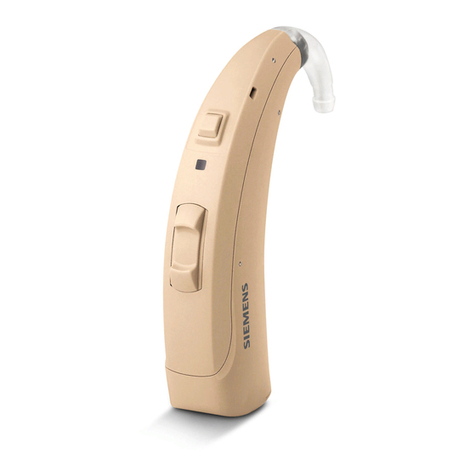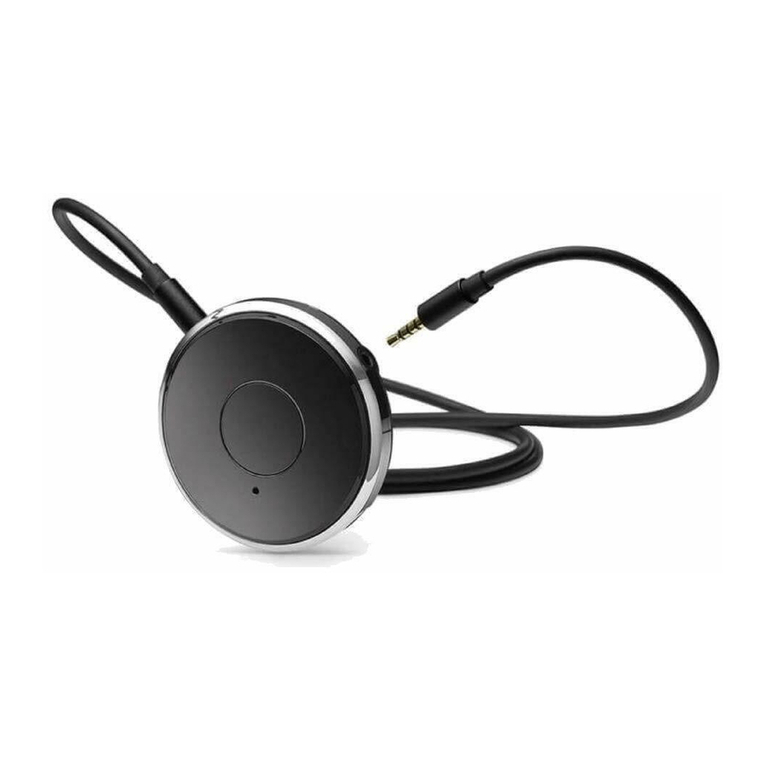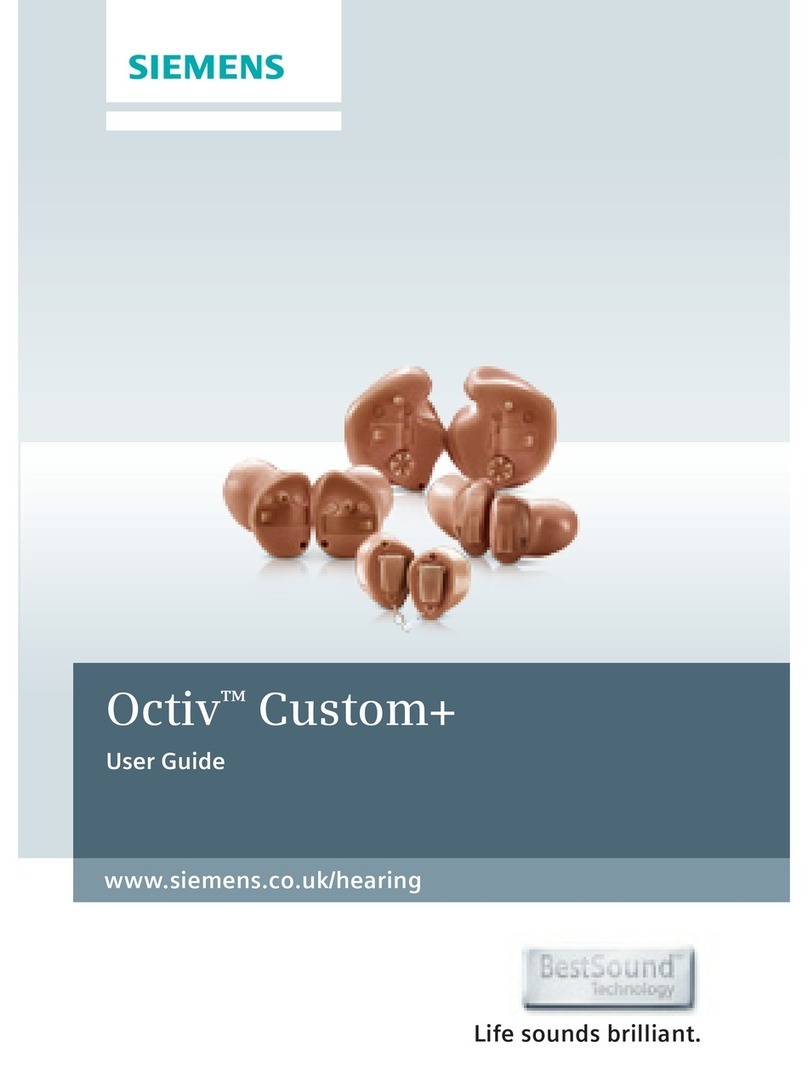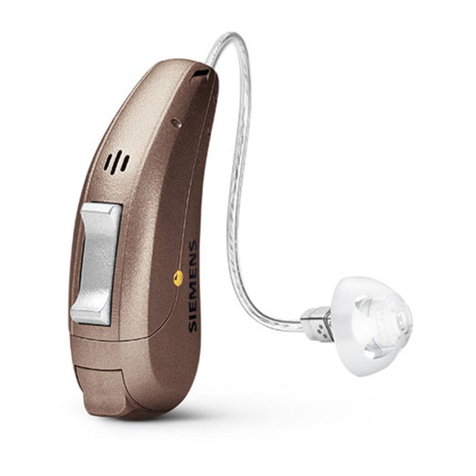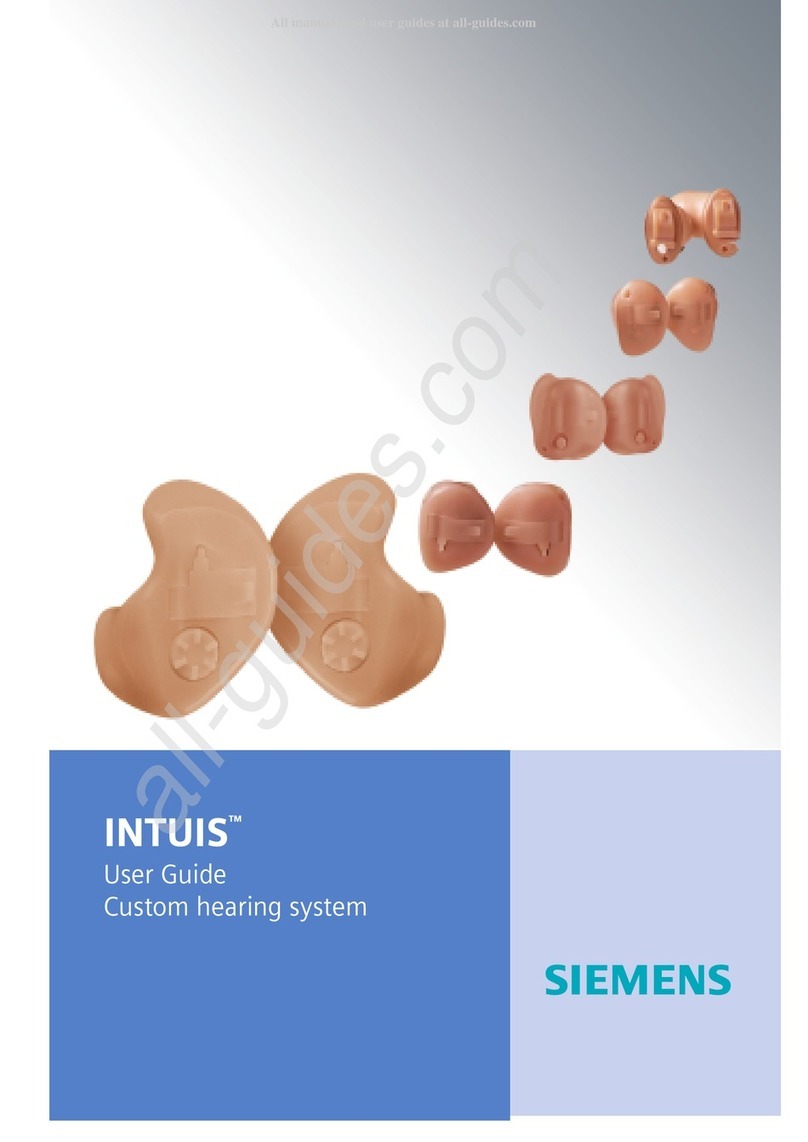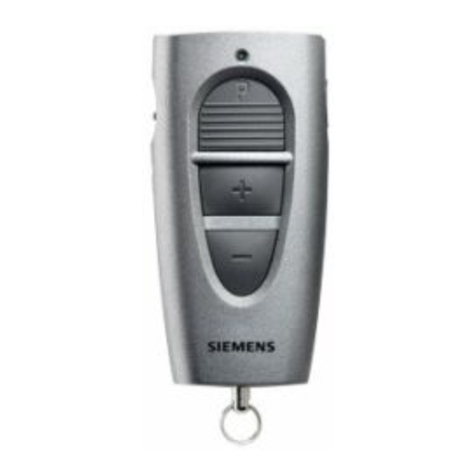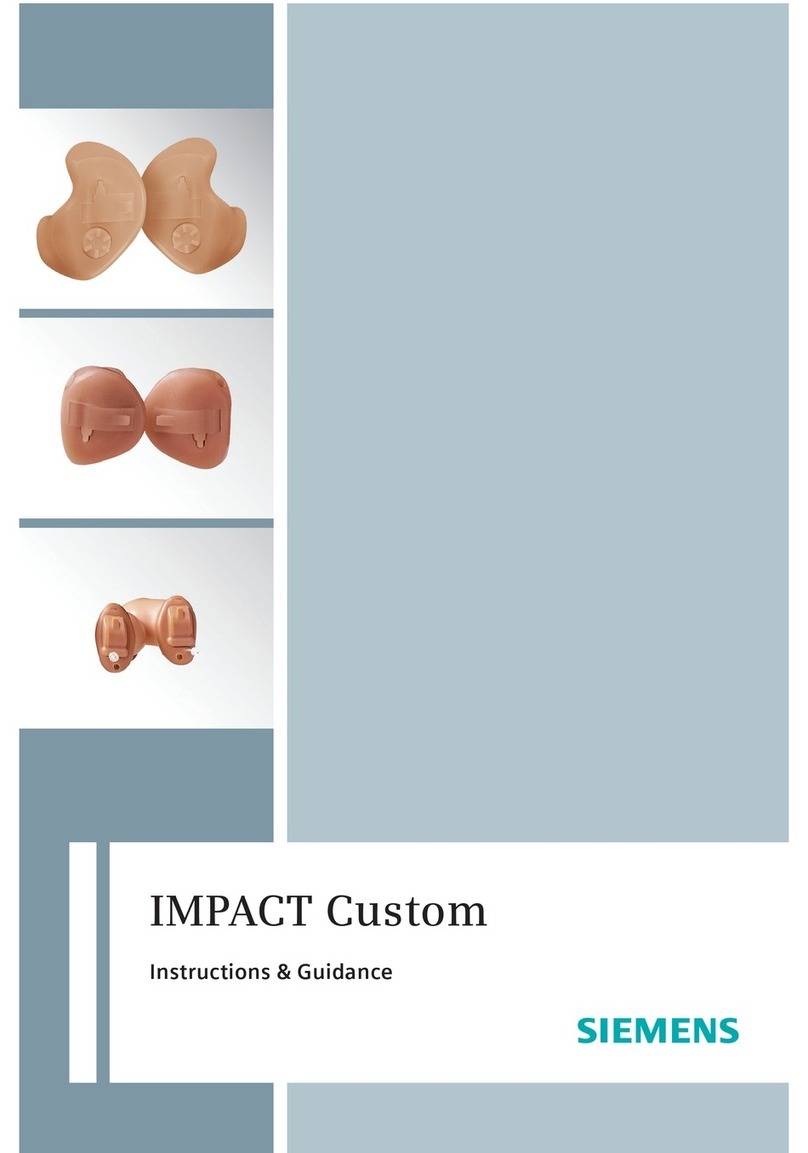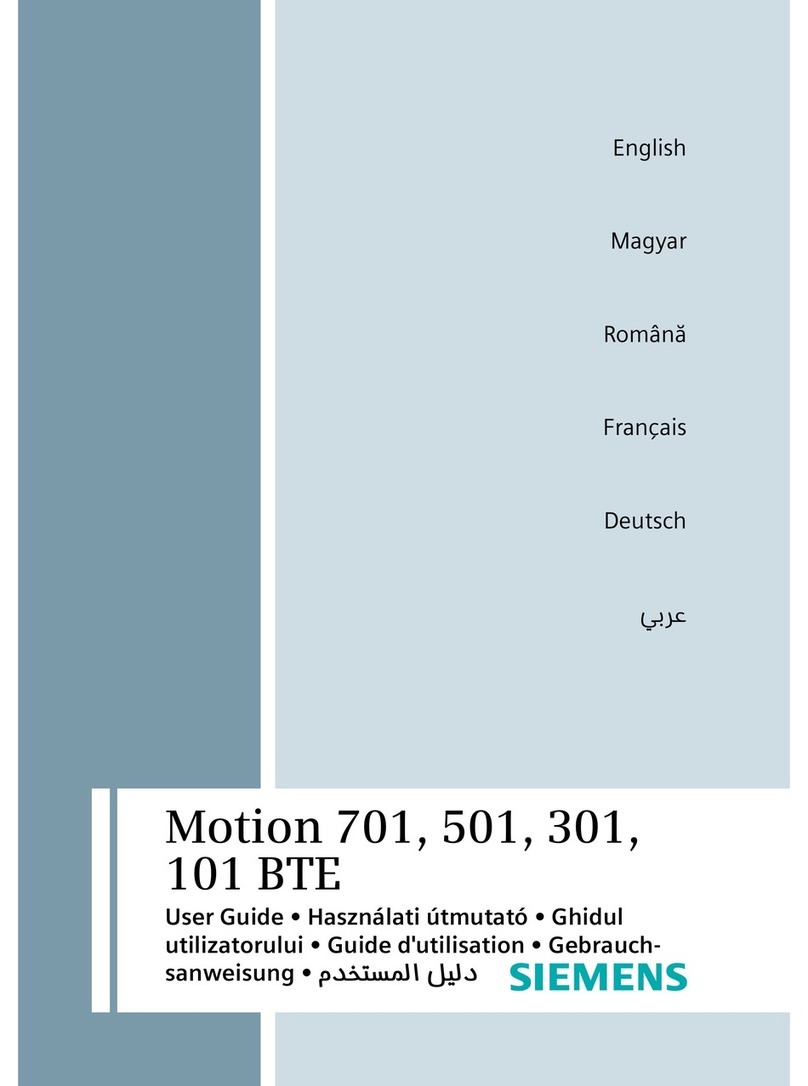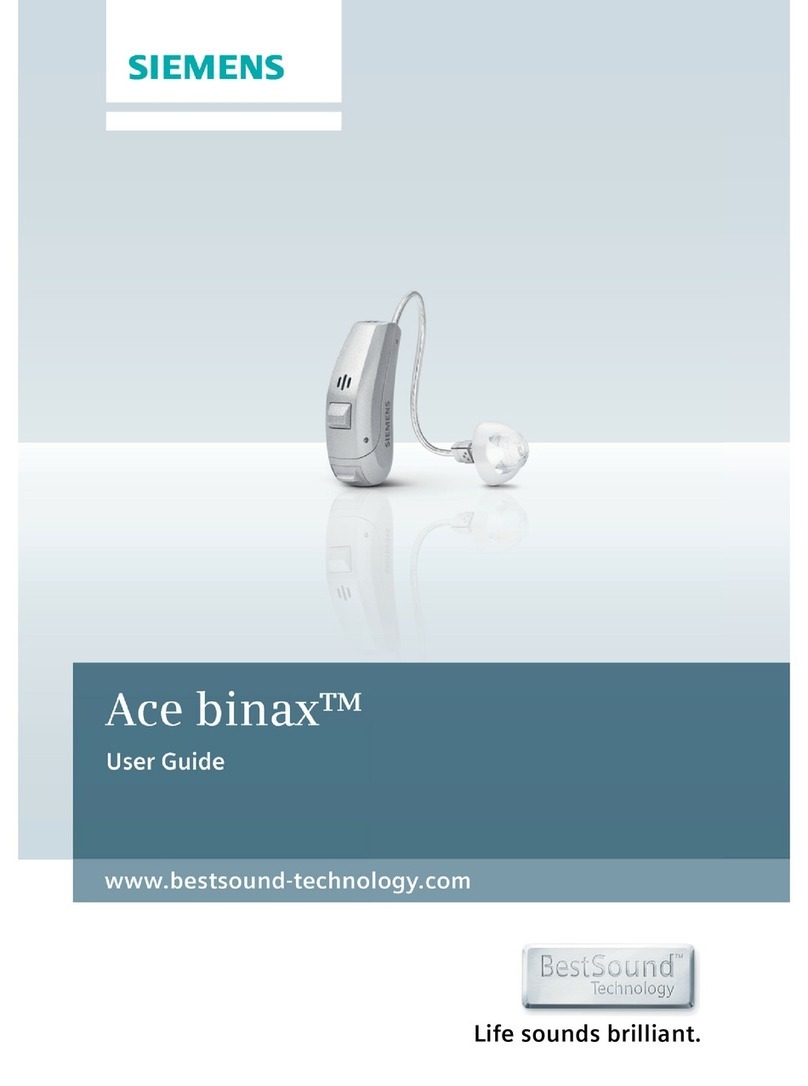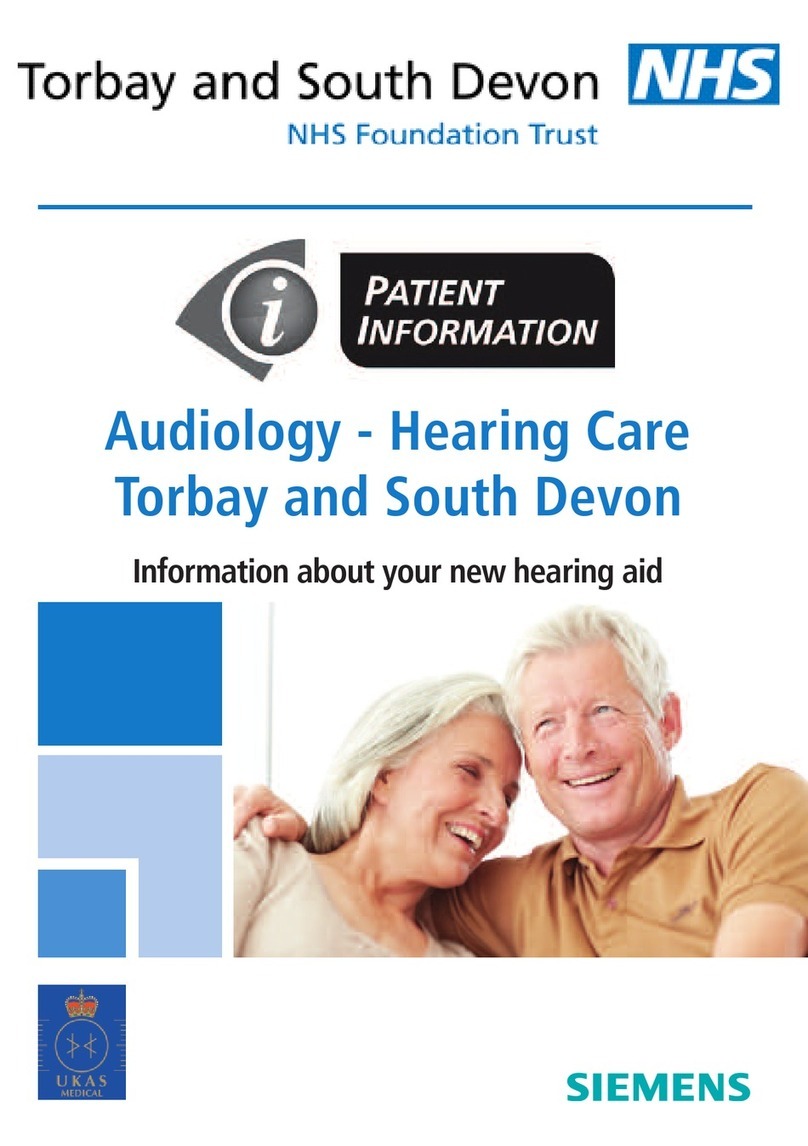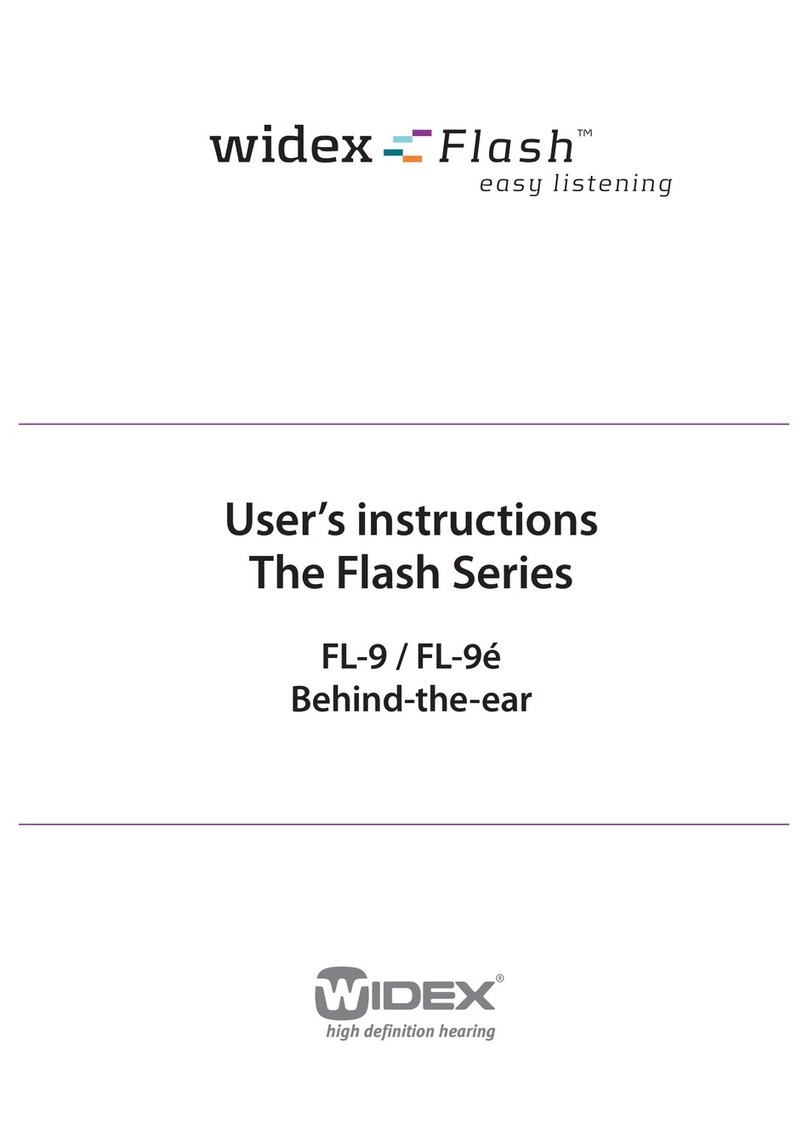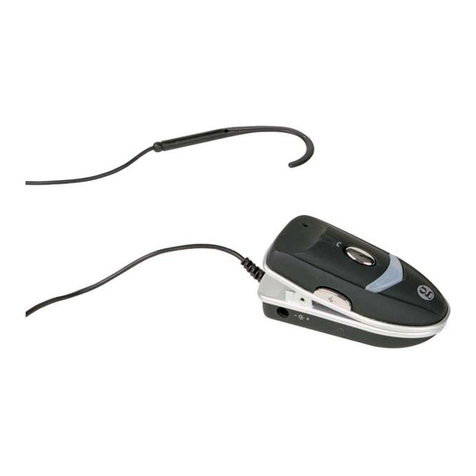Octiv S+, M+ and HP+
Instructions and guidance
United Kingdom
Sivantos Limited
Platinum House
Sussex Manor Business Park
Gatwick Road, Crawley
West Sussex RH10 9NH
Conformance information
With the CE marking, Sivantos confirms
compliance with the European guidelines,
in particular directive 93/42 EEC of the
European Council applying to medical
products.
For the products with e2e wireless
2.0 Sivantos additionally confirms
compliance with the European Directive
99/5/EC (R&TTE) concerning radio and
telecommunications terminal equipment.
Our quality management system, certified
by an independent authority, assures
consistently high product quality and
reliability to the customer.
2011/65/EU RoHs concerning the
restriction of hazardous substances
Legal Manufacturer
Sivantos GmbH
Henri-Dunant-Strasse 100
91058 Erlangen
Germany
Phone +49 9131 308 0
www.bestsound-technology.co.uk
With the controls you can, for
example, adjust the volume or switch
hearing programs. Your hearing
instruments either have a push button
and a rocker switch or a push button
only. The NHS Provider has assigned
your desired functions to the controls.
Ask your NHS Provider to mark
your controls and their functions
on the following pages.
Controls
Manufactured by Sivantos GmbH under Trademark License of Siemens AG
Based on Document No. A91SAT-02422-99T04-7600 EN-GBR | D00118953
JN7484| Pt No: 10824115 | Issue 4 | © 05.2015 Siemens AG
Push button
Function Left Right
Program
change
Volume up
Volume
down
Standby/
turn on
press briefly, press 2 seconds
Push button and
rocker switch
Function Left Right
Lock / Unlock the
controls
Read more in section "Locking the controls".
Settings
Ask your NHS Provider to mark
your individual settings on the
following pages.
Hearing programs
1
2
3
4
5
6
Read more in section “Changing
the hearing program”.
Rocker switch
Function Left Right
Program
up/down
Volume
up/down
Tinnitus
noiser
level up/
down
Sound
balance
Standby/
turn on
press briefly, press 2 seconds,
press 5 seconds
Control Left Right
Push
button
Rocker
switch
You can also use a remote
control.
Features
Power-on delay enables
whistle-free insertion of hearing
instruments. Read more in section
“Turning on and off”.
e2e wireless enables simultaneous
control of both hearing instruments.
Read more in section “Using two
hearing instruments”.
A telecoil is built into the instrument,
so it can connect with audio induction
loops. Read more in section “Audio
induction loops”.
Exchangeable ear pieces
(only with LifeTubes)
Size
LifeTip open or
closed
LifeTip double
LifeTip
semi-open
Accessories
Remote control
Battery size and ear pieces
Batteries
Non-rechargeable (size 13)
Non-rechargeable (size 312)
Tinnitus noiser
Your hearing instrument may be equipped with a tinnitus noiser. The use
of the tinnitus noiser should be only on the advice and in consultation
with your NHS Provider.
WARNING
Risk of further impairment to the user’s hearing health.
The volume of the tinnitus noiser can be set to a level which could
lead to permanent hearing damage when used for a prolonged
period of time.
The tinnitus noiser should never be used at uncomfortable
levels.
WARNING
Risk of further impairment to the user’s hearing health.
An NHS Provider should advise a prospective hearing instrument or
tinnitus noiser user to consult promptly with a licensed physician
(preferably an ear specialist) before using the hearing instrument or
hearing instrument with tinnitus noiser function if the NHS Provider
determines through inquiry, actual observation, or review of any
other available information concerning the prospective user that
the prospective user has any of the following conditions:
Visable congenital or traumatic deformity of the ear.
History of active drainage from the ear within the previous 90 days.
History of sudden or rapidly progressive hearing loss within the
previous 90 days.
Acute or chronic dizziness.
Unilateral hearing loss of sudden or recent onset within the
previous 90 days.
Audiometric air-bone gap equal to or greater than 15 dB at
500Hz, 1,000Hz and 2,000Hz.
Visible evidence of significant cerumen accumulation or a
foreign body in the ear canal.
Pain or discomfort in the ear.
Product safety
NOTICE
Leaking batteries damage the hearing instruments.
Turn the hearing instruments off when not in use to preserve
the battery.
Remove batteries when the instruments are not in use for a
prolonged period of time.
NOTICE
Protect your hearing instruments from extreme heat. Do not
expose them to direct sunlight.
NOTICE
Do not dry your hearing instruments in the microwave oven.
NOTICE
Different types of strong radiation, e. g. during X-ray or MRI head
examinations, may damage hearing instruments.
Do not wear the hearing instruments during these or similar procedures.
Weaker radiation, e. g. from radio equipment or airport security,
does not damage the hearing instruments.
NOTICE
Protect your hearing instruments from high humidity. Do not
wear them in the shower or when you apply make-up, perfume,
aftershave, hairspray or suntan lotion.
Only for two instruments or the use of a remote control:
In some countries restrictions for the usage of wireless equipment exist.
Refer to local authorities for further information.
Personal safety
WARNING
Risk of impairing the residual hearing of the user.
Use only hearing instruments that have been fitted especially
for your needs.
Risk of injury!
Do not use obviously damaged devices and return them to point
of sale.
Risk of explosion!
Do not use your hearing instruments in explosive atmospheres
(e. g. in mining areas).
Risk of affecting electronic equipment!
In areas where the use of electronics or wireless devices are
restricted, verify if your device has to be turned off.
Risk of interference with active and non-active implants! If you
wear an active or a non-active implant, e.g. a brain implant:
Prior to use, have the electromagnetic compatibility verified.
Consult the physician that implanted the device before using
your hearing instruments.
Keep a safe distance of about 1.6 inches (4 cm) between the
implant and hearing instruments.
Your hearing instruments may reduce certain background
sounds, potentially also traffic or warning signals.
WARNING
Choking hazard!
Your hearing instruments contain small parts which can be swallowed.
Keep hearing instruments, batteries and accessories out of reach
of children and mentally disabled persons.
If parts have been swallowed consult a physician or hospital
immediately.
Ensure adequate supervision if infants, small children or mentally
disabled persons need to wear hearing instruments.
Check the completeness of the hearing instruments regularly and ensure
that the hearing instrument does not detach from the ear mould.
WARNING
Consult your NHS Provider if you experience any unusual side
effects like skin irritation, excessive accumulation of ear wax,
dizziness, change in your hearing, or if you think there may be a
foreign object in your ear canal.
CAUTION
Risk of injury!
Always wear the tube with an ear piece.
Make sure that the ear piece is completely attached.
Risk of injury!
Insert the ear piece carefully and not too deeply into the ear.
Risk of injury!
In very rare cases the ear piece could remain in your ear when
removing the hearing instrument. If this happens, have the ear
piece removed by a medical professional.
Important safety information
Storage Transport
Temperature 10 to 40 °C -20 to 60 °C
Relative
humidity
10 to 80 % 5 to 90 %
Air pressure 700 to
1050 hPa
200 to
1200 hPa
For other parts, such as batteries,
other conditions may apply.
Intended use
Hearing instruments are intended
to improve the hearing of hearing
impaired persons. Diagnosis and
prescription of a hearing instrument
must be performed by hearing health
specialists, e.g. acousticians,
audiologists or ENT doctors.
Use the hearing instruments
and accessories only as
described in this user guide.
Transport and storage
conditions
During extended periods of
transport and storage, please
observe the following conditions:
Important information
NOTICE
To avoid environmental
pollution, do not throw
batteries into household
waste.
Recycle or dispose of
batteries according to
national regulations or
return them to your
NHS Provider.
Recycle hearing
instruments, accessories
and packaging according
to national regulations.
In case of instrument failure
Is the instrument switched on?
Is the battery inserted correctly?
Is the battery run down?
Is the battery compartment
closed?
Is the sound opening in the ear
mould clogged with wax?
Technical information
FCC ID: SGI-WL002BTE
IC: 267AB-WL002
Operating frequencies: Fc=3.28 MHz
Disposal information
Within the European Union, the
marked equipment is covered by
“Directive 2002/96/EC of the
European Parliament and of the
Council of 27 January 2003 on waste
electrical and electronic equipment.”
Amended by “Directive 2003/108
EC” (WEEE).
0123
Hearing instrument emits
whistling sounds.
Reinsert the ear piece until it fits
securely.
Decrease the volume.
Clean or exchange the ear piece.
Sound is distorted.
Decrease the volume.
Replace the empty battery.
Clean or exchange the tube and
the ear piece.
Hearing instrument emits signal tones.
Replace the empty battery.
Hearing instrument does not work.
Turn the hearing instrument on.
Gently close the battery door.
Replace the empty battery.
Make sure the battery is inserted
correctly.
Power-on delay is active. Wait
several seconds and check again.
Troubleshooting
Sound is weak
Increase the volume.
Replace the empty battery.
Clean or exchange the tube and
the ear piece.
For NHS Providers:
The target population is primarily the adult population over 21 years of
age. The patient may have some control of the level or volume of the
signal and the patient should discuss this adjustment as well as his or her
comfort level and sound of the signal with their NHS Provider.
WARNING
Risk of further impairment to the user’s hearing health.
The volume of the tinnitus noiser can be set to a level which could lead
to permanent hearing damage when used for a prolonged period of time.
Should the tinnitus noiser be set to such a level in the hearing
instrument, advise the user of the maximum amount of time per
day he or she should use the tinnitus noiser.
For example, occupational safety guidelines restrict continuous
noise exposure of 80 dBA SPL to 8 hours per day.
The tinnitus noiser should never be used at uncomfortable levels.
NOTICE
Your hearing instruments
are designed to comply with
international standards on
electromagnetic compatibility
but interference with nearby
electronic devices could occur.
In this case, move away from the
source of interference.
www.bestsound-technology.co.uk
miniTek™wireless enhancement
Your Octiv + hearing instrument
can be used with the miniTek wireless
enhancement system. miniTek
provides a wireless connection from
your Octiv + hearing instruments to
your television, mobile phone, MP3
player and stereo. miniTek is also
an easy-to-use remote control for
your Octiv + hearing instruments for
convenient and discreet program and
volume adjustment. The miniTek
package comprises the miniTek
itself which controls the hearing
instruments, a Tek transmitter and all
cables necessary to link the miniTek
into a variety of devices such as TVs,
MP3 players, etc.
Octiv+ instruments are miniTek
and easyPocket compatible.
The easyPocket remote control is
available as an optional accessory
allowing for convenient and discreet
hearing instrument adjustment.
It is extremely ergonomic, has an
easy-to-read display and a modern,
stylish look.
Optional
NOTICE
miniTek and easyPocket™are additional products to your hearing
instrument which may be available to purchase. If you think it would
assist you in your day-to-day life talk to your NHS Provider about how you
can obtain a miniTek or easyPocket. Further information is available on
our website www.bestsound-technology.co.uk or
miniTek
easyPocket
